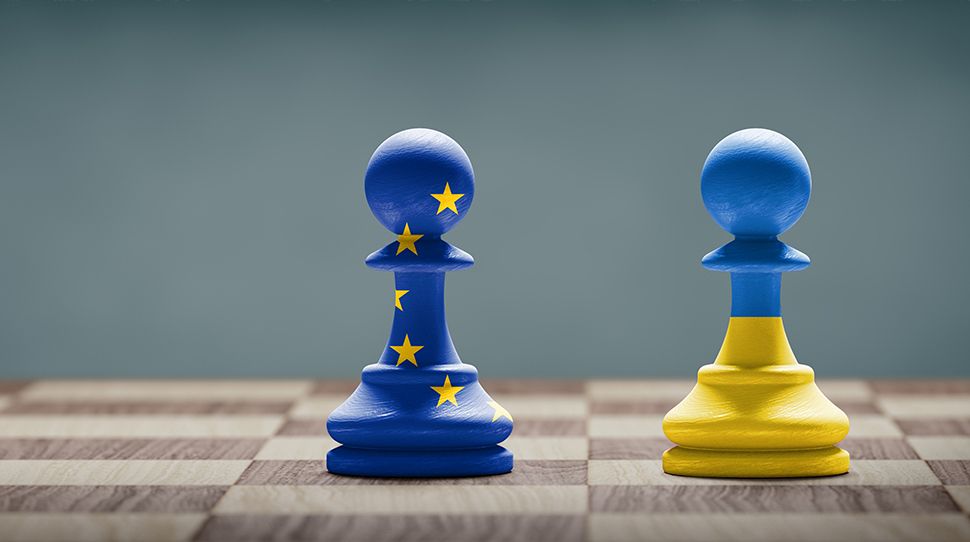Ukraine war: Army General Gomart sheds light on the great stakes

Afghanistan, Chad, ex-Yugoslavia, Libya, Iraq, Syria, Mali, French Army General Christophe Gomart has served in all the combat zones that have threatened the world balance in recent decades.
Lieutenant General, former Commander of Special Operations and former Director of Military Intelligence, he now has a discerning eye when it comes to the war in Ukraine whose beginnings go back to 2014. At that time, in the Donbass region of eastern Ukraine, a conflict broke out between the pro-Russians and the new authorities in Kiev, ending with the Minsk agreements. Eight years later, this territory is once again witness of deadly clashes with huge and stressful consequences worldwide.
General Christophe Gomart led a conference on 7 December before some fifty Indosuez France clients who had the opportunity to get a better grasp of the implications. The discussions continued for quite some time during the cocktail that followed the event.
Selected excerpts from the conference
With all the information you must be aware of, did you feel that a major armed conflict was about to break on 24 February?
In 2014, when 40,000 Russian soldiers were stationed along the Ukrainian border, as Head of Military Intelligence I had to address the question of the outbreak of a conflict.
So Ieveraged the autonomous assessment capacity that France has today thanks to the combination of four sources that are its satellites, its interception capacity, its cyber research capabilities and its people (diplomatic and military networks, etc.), making it possible to cross-check the data.
At the time, I thought that if there was no armed conflict, there would rather be a destabilisation phenomenon. Indeed, the Russian troops, especially paratroopers, did not seem to be actively engaged as there were no field hospitals deployed and, above all, the soldiers’ mothers who represent a key indicator were talking about how their sons were bored due to lack of training; and the attack finally took place 8 years later!
Why this decision to make war on Ukrainian soil?
The eastern Ukrainian territory is quite pro- Russian. Kiev was the first capital of Russia between 980 and 1169 and the Orthodox Patriarchate was based there. In contrast, the western flank of Ukraine is closer to Poland and Lithuania and is predominantly Catholic. The two areas are separated by the natural barrier of the Dnieper river. Crimea was not attached to the Ukrainian Soviet Socialist Republic (then part of the USSR) until 1954, but it offers Russia and its fleet the advantage of its ports and access to the Black Sea.
The Donbass region is a coal basin with large grain plains that is closely linked to Russia by its population.
In 2014, the overthrow of the Ukrainian President led to a conflict between pro-Russian separatists and the new Ukrainian regime that resulted in 15,000 deaths and in the signing of the Minsk agreements later in 2015.
Since then, the artillery fire between the two belligerents has never stopped. Last February, Vladimir Putin thought that Ukraine would fall in a few days, but this was without taking into account the unfailing resistance of Volodymyr Zelensky and Ukrainian people’s resilience.
What has happened since February?
During the first night of the conflict, the Russian army fired 163 missiles and approved 100 to 200 aircraft sorties (by way of comparison, during the war in Iraq, the US army fired 500 missiles and 1,700 aircraft sorties were authorised), proof that the ambition was not to destroy the country but simply to change the government.
The Russian army was not prepared for long-term combat and was confronted with the uprising of the entire nation against the invader. Faced with this first failure and in order to continue their attack, the use of artillery to open the way on the Russian side was massive, so much so that the 150,000 Russian soldiers mobilised managed to advance the front. By mid-December 2022, the Russians occupied about 17% of Ukrainian territory. Finally, the Russian army had a very Soviet command model, which was therefore quite rigid (with no initiative left to the subordinate levels) and with very little communication between the regions and within the different commands.
Also, despite the very large volume of ammunition used, the progressive adaptation to the difficulties faced on the battle ground, and the stronger mobilisation, the Russian army has not progressed since this summer and has stabilised east of the Dnieper. The main reasons for this are the Ukrainian army's capacity to adapt and mobilise. While the Ukrainian army was getting stronger by "otanising" itself, the Russian army on the other hand was starting to weaken.
What was Vladimir Putin's response to the stalemate?
The Russian authorities decided to destroy the Ukrainian energy infrastructure by means of missiles fired from Russia, which led to a retaliation in the form of attempts to destroy Russian bases by Ukrainian drones; this is the situation today.
What about the international balance today?
Russia is determined to take back Crimea and the Donbass.
The United States, a real economic competitor, delivers ammunition to Ukraine on condition that Russian territory is not targeted. Volodymyr Zelensky wants to drag NATO into a war that nobody wants.
How to get his war behind us?
The Ukrainians are convinced that they can push the Russian forces back to their 1991 borders. However, I question their ability to do so and to obtain enough support from the Americans and Western countries.
On the upside, the Russians at least aspire to keep their current positions: the Dnieper supplying the Crimean peninsula with fresh water and the Zaporizhia nuclear power plant feeding Dombass and Crimea with electricity.
We are witnessing a war of communication on the part of the belligerents and it is advisable to remain very cautious about what is said in a given situation. It is the responsibility of the intelligence services to use all information sources and to process all the data available so as to establish an objective and precise state of affairs.
What learnings do you draw from this war?
First of all, I would say that from now on, in terms of intelligence, everything is open and extremely transparent. Social media and the content published on these channels allow us to have an extremely precise view of what is happening on the ground.
For an army, it is necessary to have a transmission bubble to remain protected, especially when it comes to command posts. It is now crucial to the performance of armies. This transmission bubble established thanks to Starlink allowed the Ukrainians to communicate with each other using means that could not be intercepted and to make command more fluid, something that did not exist with the Russians.
Another lesson is the need to have a huge quantity of ammunition.
We know, for example, that it takes two years to build the Cesar gun. In terms of production capacity, we are not yet in a war economy.
The resistance and resilience of the population are also real lessons, and so is the capacity to inform the army.
Today, peace has been eroded across the world but dialogue still remains, nurturing hope for a more peaceful future.
December 16, 2022




